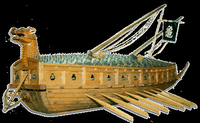
I’m sure you’ve all seen the movie
It looks like they were only used in river systems until 1859, when the French launched the first ocean-going ironclad called the La Gloire ("Glory"). Twenty-one months later, the British launched their version, called the HMS Warrior. In 1861, the first steam-powered ones were built for the American Civil War.
Subsequently, the Swedish, Spanish, Italian and many other European countries made us of these “river monitors”. Only drawback, while the ironclads were powerful, it was nearly impossible for the crew to escape if they were holed in deep water by a mine. The age of the ironclad came to an end in 1890, when they were replaced with pre-dreadnoughts.
All warfare is based on deception. Hence, when able to attack, we must seem unable; when using our forces, we must seem inactive; when we are near, we must make the enemy believe we are far away; when far away, we must make him believe we are near. Hold out baits to entice the enemy. Feign disorder, and crush him.
- Sun Tzu, the Art of War







No comments:
Post a Comment